SaaS products are everywhere. Take an individual’s personal life. Netflix, Whatsapp, Spotify — all of these have become prominent. Now shifting to professional space, there is G-suite, Slack, and many more.
SaaS is gaining even more popularity after COVID-19. And it is set to explore many areas in the future. Building a SaaS product, now, has a lot of scope in the market. But the process, sadly, is not a cakewalk.
It requires several strategies to build a complete product. We are here to discuss how to build a SaaS product step by step.
Let’s begin.
What is a SaaS product?
The term SaaS stands for Software-as-a-Service. SaaS products are software that users can access via the internet. As opposed to traditional software installed in a device, SaaS can be used from any device.
SaaS products are mostly provided on a subscription basis instead of a one-time purchase. Users have the freedom to cancel the subscription at any time.
Some famous SaaS companies to make it relevant for you
- Dropbox
- Office-365
- Box
The SaaS model eliminates almost all drawbacks in traditional systems like installation times, maintenance charges, etc. Now after the pandemic and remote access being the utmost need for companies to stay in business, the SaaS adoption rate is growing. Here is the graph from Profitwell. It shows the growth of the subscription index of SaaS companies during the initial months of COVID-19.
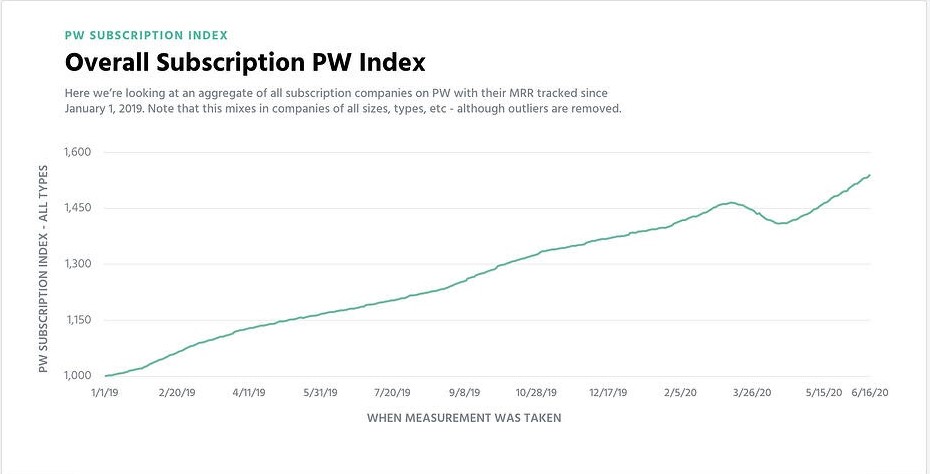
Also, according to Technavio, the SaaS market size is projected to reach $60.36 Billion by the year 2023.
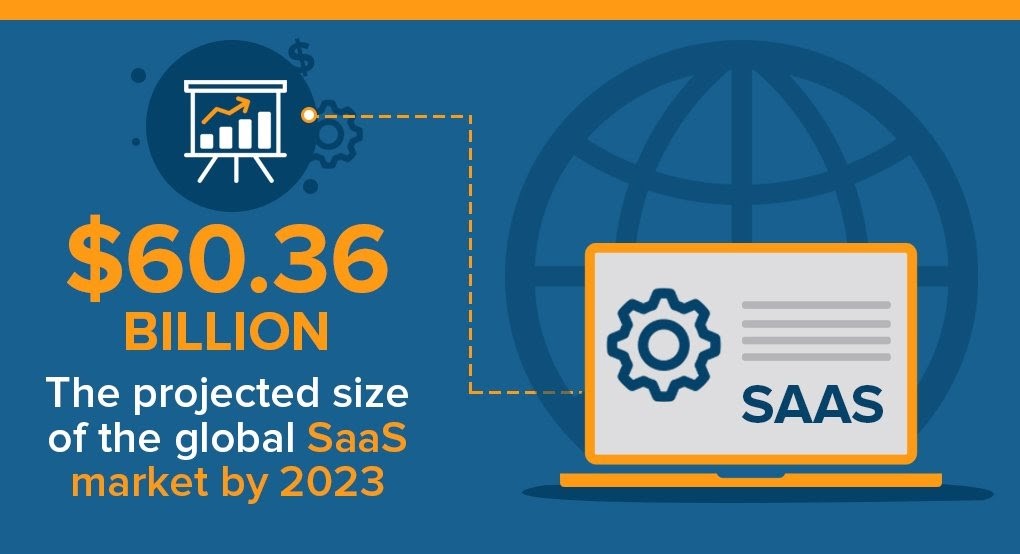
Why SaaS technology?- Advantages
The SaaS market is growing every year and usage of SaaS products is only going upscale. But, why is it popularly sought? Here are a bunch of reasons to justify it from the customer as well as the provider’s end.
- Time
- Traditional software had a time gap between purchase and usage. But SaaS applications are quick to deploy. Customers don’t have to wait for technicians to install applications for them. SaaS products are already installed in the cloud. They are just a purchase and few basic configurations away from usage.
- Scalability
- SaaS products usually have either a pay-as-you-go or subscription-based payment model. Companies, as they grow, will look for a change of plans. And in SaaS, they have the flexibility to scale up and down, based on the requirements.
- Remote access
- The pandemic made big businesses realize something major — being able to connect and do work remotely. This is what exactly the SaaS model offers: remote accessibility. SaaS products can be used from anywhere with just an internet connection in place.
- Easy updates
- For customers, SaaS comes with a seamless update experience. With traditional software, companies had to buy upgrade packages and spend time on installing them. SaaS eliminates this problem by giving updates with just a click. Providers take the sole responsibility and ensure the software is up to date.
- Cost
- SaaS is subscription-based and doesn’t have any licensing or maintenance costs. SaaS products come with a different range of pricing plans. And startups with not much upfront investment can choose a plan that suits their requirement and budget. It’s pretty clear now that SaaS is affordable.
How to Build a SaaS Product?
Developing a SaaS product from scratch
1. Come up with an idea
All the great products begin with a single streak of thought. Later these thoughts evolve into ideas. And ideas form the base of the products.
The SaaS product ideas are basically generated in two ways. One: They occur to you through personal experiences. Two: You seek them through various sources.
Irrespective of the source, all the product ideas are born out of one common agenda — to solve user problems. The customer pain points are based on two reasons. Either they don’t have the right product to address their needs or the existing products are not satisfactory enough.
If you have decided to build a SaaS product but don’t have an idea yet, here are a few ways to look for one.
- Surfing the App Store reviews (unsatisfied user reviews are a great source)
Review on a storytelling app:

Review on a health care and fitness app:

- Talking to friends and relatives (uncovers their agonies and difficulties concerning SaaS products)
- Researching the internet (Quora and Reddit discussions provide you with a lot of insights)


Remember— Ideas always seem exciting in the beginning. But you shouldn’t plunge directly into building the product, driven by that zest. It’s the next step that ultimately decides if your product idea is worth pursuing.
2. Research the market
Ideas make you build castles in the air. That is why an idea validation process that gives you a reality check is necessary.
Not all ideas have the potential to satisfy the customer, bring business profit, and succeed among the competitors. Consider the idea validation as a filter. As your SaaS ideas pass through it, you get to know which idea is most feasible.
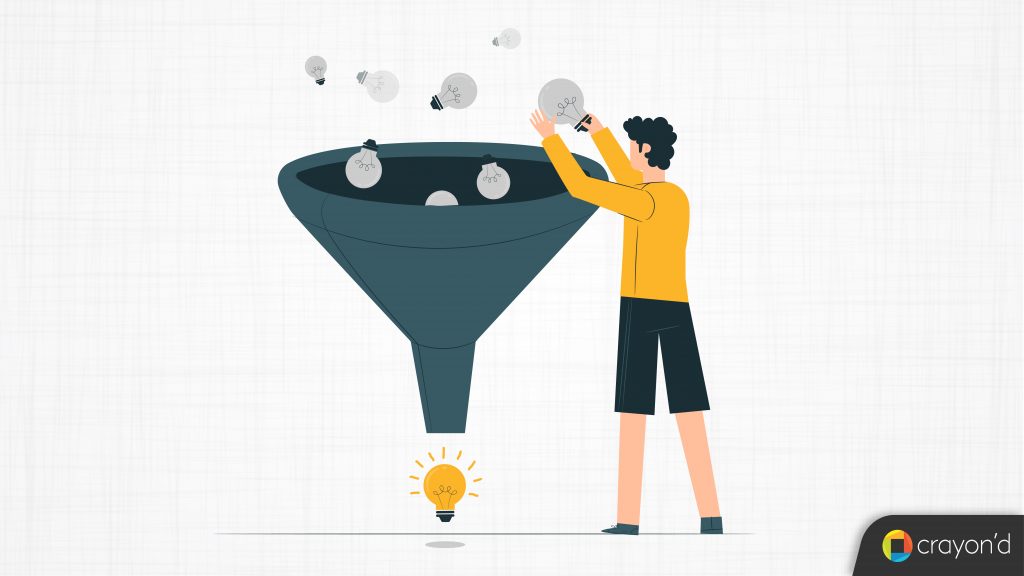
Validation is done by conducting SaaS market research. The two major aspects of this research are target market and competitor analysis.
- Target Market Research:
In target market research, the following questions will give a lot of insights.
- Who will benefit from your product?
- How big is your target market?
- Is their problem big enough that they will pay for a solution?
- How often will your target customers use your product?
- Is there a real demand for the solution you are creating?
When you conduct the target market research, you should take the product-adoption curve into account. There are 5 classifications of adopters based on the time taken to buy your product — innovators, early adopters, early majority, large majority, and laggards.
In building a new SaaS product, it’s essential to clearly understand the people in the first two categories. They are the ones who decide if your product and the idea behind it are worthy enough. Their opinion of your product determines the purchase decision of the rest of the categories.
Along with that, you can define the long-term vision of your product by asking this question,
“If your idea were to become a product, will the different categories adopt it?”
- Competitor Analysis:
The SaaS field is experiencing rapid growth. And popular niches have existing biggies and budding players. Unless you come up with a completely new idea, you have competitors.
Having a complete understanding of competitors can help you know
- How is your idea/solution different from theirs?
- Why would the users prefer your product over the others?
After you validate the ideas, you move ahead with the best one. Now, the remaining part of the market research will help you shape your product. The first step is defining the target users.
- Age
- Income
- Gender
- Demographics
- Purchase pattern
Then do the competitor research that will help you know their features, strengths, and weaknesses. This will help differentiate your product from the existing ones.
3. Device a business plan
Now that you have a collected data, you have to use them for framing actionable strategies for your SaaS product. With the insights, the data provided, proceed with the business planning.
In the development process, you should have clarity on every single step ahead. For this having a business plan in place is vital. It acts as a roadmap for your product. Every SaaS product is different, but a basic business plan must define the following.
- Product Vision
Product vision statement decides the rest — product strategy, roadmap, and backlog. A vision statement must include the product’s goal concerning the customer’s pain points. It sets the mood for the rest of the processes. For example, Tesla’s vision statement is
“To accelerate the world’s transition to sustainable energy“.
- Unique Selling Point (USP)
The competitor research will give an idea of what the others in the market are offering. With that alongside, you must decide what your product has to distinguish it from your competitors.
USP statements should help you stand out from the crowd. But rather than just being a slogan, it should be something that can be incorporated anywhere in your SaaS business. And it should be focused on what your target customers care about. Here is the USP of FedEx. The customer’s pain point here is the inability to transport things quicker.

- Finance
Finance is the key to building and running the business. Either to start or to keep a business running, money is primary. Here, it can be categorized into two, investment and monetization plans.
Only with the initial funds, the development process can kickstart. Decide what would suit the best— own budget, funds from investors, or crowdfunding.
Coming to the second part, we have discussed monetizing your product under the topic “Plan the pricing model”.
- How to reach and attain customers?
Your SaaS product is made for the market. What’s the purpose of putting so much effort into building a product that goes unnoticed among the target customers?
To ensure the product’s entry to be smooth and loud, you must come up with a go-to marketing strategy. And it has to be done right at the beginning. This helps you decide and have everything in place — acquisition strategies, marketing plan, demand generation methods, and a sales model.
Your business plan is a package of strategies you should keep in mind and come back referring to often.
4. Determine the cost
Every step in building costs you money— from research, validation, execution to marketing. Estimate the expenses beforehand and plan each process accordingly.
If you ask “How much does it cost to build my SaaS product?“, there is no single answer to it. The cost is relative and unique to each product. But for all SaaS products, these aspects influence the expenditure
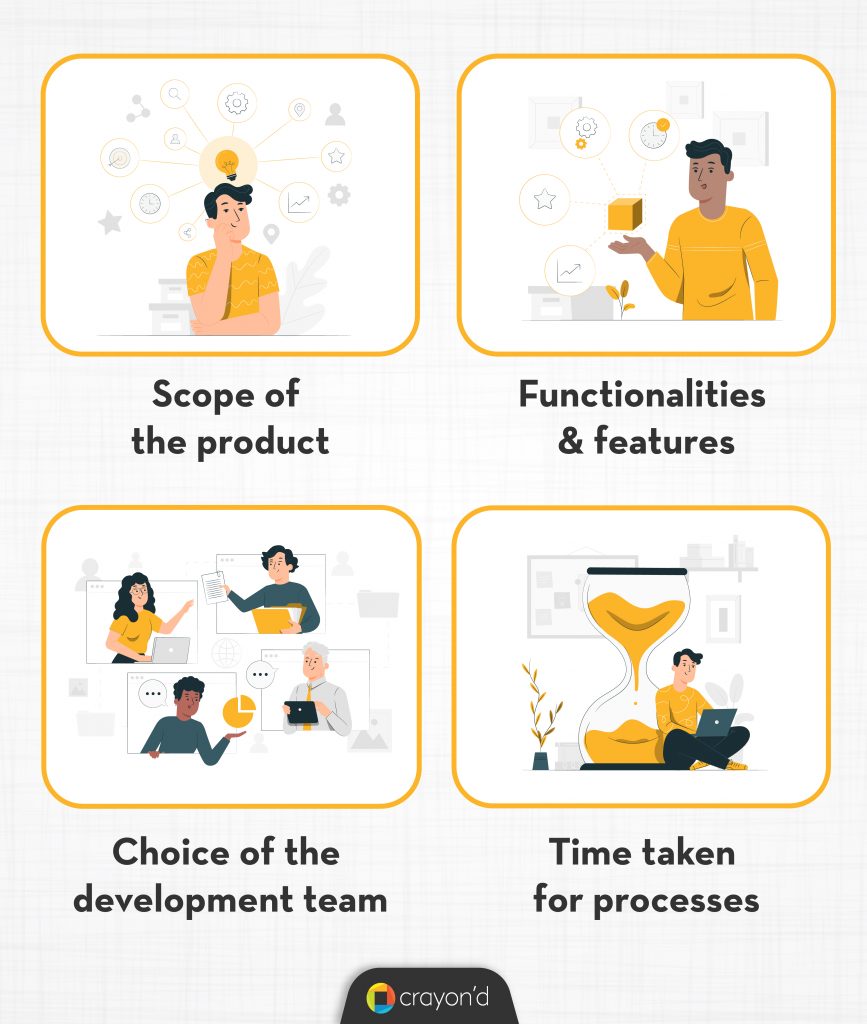
The processes that cost you ‘time’ include idea validation, planning, UX, and other management operations. You have to take these into account when planning the cost.
Concerning the SaaS framework, the launch is not the end of your job. Maintenance is also your responsibility. And there are continuing expenses related to it like hosting and ongoing development. Then comes the well-known costs for building— tools, designing, and development (Front end, backend, and integration).
User acquisition and marketing also add up to the list. Once cost planning is done, you can easily track and control the proceeding processes.
5. Identify the SaaS requirements
Now, you come to the most important question, “What makes your product SaaS?”
The SaaS model has some basic features that set it apart from the rest. Ensure the incorporation of the following features based on the nature of your product.
- Integration
It’s the digital era and most companies use several applications. So your SaaS product framework should be easy to integrate with the existing ones. This way the users will work seamlessly with your product.
- Customization
Even though SaaS products have a shared structure, customers have varied needs. The ability to customize them based on the needs is highly sought by the customer base.
- Automated provisioning
The speed of processes has increased in today’s world. To cope with it, build SaaS applications that enable automated delivery and onboarding services.
- Authentication systems
Companies have started to rely completely on SaaS products for most of the business processes. And it involves a lot of data handling. SaaS applications must employ authentication systems like Single Sign-On and Multi-Factor Authentication for enhanced security.
- Multitenant architecture
Multitenancy is the ability to support multiple customers at the same time. The users share the same instance of the software. It’s fast, efficient, and easy to maintain.
- Audit and activity tracking
Having audit logs will provide your users with an option to trace back to events and find where things went wrong. SaaS products with this feature are highly effective as it contributes to operational security and activity tracking.
Along with basic SaaS requirements, you must decide on the other key features you want your product to have. Using the data from competitors, finalize the core and additional features. You can use prioritization techniques to help you out.
6. Choose the right tech stack
Features have been decided. Now, your concern should shift to the technologies that help you develop these features. Tech stack is the set of programming languages, tools, and frameworks needed to build the product.
In SaaS product development, there are two separate modules— the front-end and back-end. In addition to these tech stacks, SaaS products require hosting tech stacks too.
Frontend:
Everything the user sees and interacts with the screen comes under the front-end. Some popular examples for frontend stack are
- Angular Js
- React Js
- Bootstrap
Backend:
Backend is server-side and is responsible for all the functionalities and performance of the product. Backend stack options include
- Ruby on Rails
- Django
- Node.js
The database is an organized collection of information. Some popular database tech stacks are
- MongoDB
- Redis
Hosting:
SaaS applications are hosted on the cloud. Some mostly sought cloud providers are
- Amazon Web Services
- Microsoft
Here’s an example of Google’s tech stack for your reference.

A variety of technologies have emerged in recent times. Every one of them has certain capabilities and some limitations in them. So the tech stack decides whether or not your product will end up the way you expected it to be. Choosing the right tech stack decides the successful outcome.
7. Gather people for your team
It all comes down to the hands of the people, your team on how your product will shape further. In building your SaaS product, teamwork is crucial. Your team should understand the vision and align with your goals. A SaaS product team should consist of
- Software developers
- Designers
- Testers/Quality assurance
- Business analysts
- Project manager
- Marketing
If you need complete control over the product development process, you can hire individual talents and form a team. For hiring, there are various platforms, where you can conduct a hiring campaign.
If you think the hiring to development cycle will consume time and energy, you can consider outsourcing the development work. This can be done for the entire process or just a part of it. There are several freelancers out there to whom you can outsource.
If not, there are product development companies that take up the entire responsibility of building your SaaS product.
8. Define and build your MVP
MVP is another way of validating your SaaS product idea. But unlike in the first step, you validate your core idea by testing it with actual users.
MVP is the minimal version of your product with just basic features that is enough to appeal to the early adopter groups. It is built considering the main pain point your SaaS product will solve.
But what to and not to include in your MVP? All the data from your early research fulfills its life’s purpose here— they are utilized.
To begin with, you have to define your MVP.
- Write down the main user pain point and needs.
- List out the business needs.
- Note down your competitor’s shortcomings and mistakes.
- Decide the value proposition of your MVP
- Write all the features and select the ones that will suit your value proposition.
It’s time to start building your MVP. Start with mapping the user flow followed by the development process. Here, your ultimate aim should be to develop MVP in the shortest time possible. MVP must contain only the basic functionalities to solve the pain point, nothing more nothing less. But remember one important point here— Never compromise the quality. To summarize, this is the process of building MVP:

Once the MVP is developed, it should look like a basic version of your future product, but fully functional.
9. Plan the pricing model
A product of your dreams is almost ready. You look back at the time, energy, and efforts you have put into it. And it all deserves a reward— profitable revenue. Without a monetization strategy in place, you might either undercharge or overcharge. In the first case, you will be losing the money. In the latter, you will be losing potential customers.
Finding the balance between the value you provide and the revenue you gain is critical. It is possible only when you look into a variety of pricing models, strategies and come up with the right pricing for your product.
Here is a list of pricing models used by the SaaS companies.
- Flat-rate
The product is offered with a single set of features that is priced at a single rate without any more differentiation. The users are charged with the same price monthly or yearly, irrespective of the level of usage.
- Per-user
The product is charged based on the number of users. A single user pays a particular amount and whenever another user is added, the price increases. With every new user accessing the account, the pricing goes high.
- Per feature
The model is also known as ‘add-on’ pricing. Here the basic features of the product are offered at a particular price. As more features are being opted for, the prices increase. The value provided is directly proportional to the pricing, in this model.
- Tiered
The product is bundled into multiple packages. Each package contains a different set of features that are charged with different price points. This model can be used to address a variety of buyer personas with different tiers.
- Usage-based
This model is also called “Pay as you go”. The customers are charged based on the usage of the product for a particular period. The usage criteria can be set to anything like the number of transactions, gigabytes of data used, etc.
- Freemium
Customers can use the product for free with access to limited services. When they require additional features or usage or capacity, they need to upgrade their plan from free to paid.
Along with the model, you have to be aware of the below pricing strategies to choose your product pricing. The most common strategies are
- Penetration pricing
Reducing prices to very low levels for enabling easier adoption.
- Captive pricing
Low price for core features and additional charges for features that enrich and make the product complete.
- Skimming pricing
High initial prices creating hype and reducing prices later to enable adoption among various categories of tech adopters.
- Prestige pricing
Higher pricing to denote luxury and standards.
- Value-based pricing
Pricing is based on the perceived value of the product.
- Free trial pricing
No prices for a limited period.
10. Test your MVP and iterate
Your SaaS MVP is launched. You have put all your sweat and blood into it. And it’s time for the results. You can test your MVP in several ways.
- Customer interviews
- Landing pages
- Ad campaigns
- Crowdsourcing campaigns
- Social media campaigns
After testing, you need to sit and analyze the results and it narrows down to one question- Did the customers love it?
If not, remember MVP is all about the Build-Measure-Learn loop. As you measure the results, you will understand what is missing in your MVP. You can begin again with building the MVP incorporating the changes.
This loop is a technique that will bring you closer to achieving Product-Market Fit. Each iteration, your MVP is aimed at it.
11. Establish the SaaS metrics to measure
If estimations and plannings are for the development phase, metrics are for the post-launch phase. Your product in the market is like a toddler that needs regular care and monitoring.
Most of all, you need to know how your product is performing in the market. And metrics are a great way to inform that. This choice of SaaS metrics depends on individual products and the nature of their service. Yet some metrics are common for all SaaS businesses.
- Monthly Recurring Revenue
- Customer Acquisition Cost
- Churn- Percentage of customers who unsubscribe from your product service.
- Net Promoter Score- How many customers are likely to recommend your product to others?
- Customer Lifetime Value- Revenue from a customer during their entire time with your product.
In addition to this, there are a variety of SaaS metrics ranging from revenue, usage to customer success, etc. So as you launch your product or even before it, decide on what SaaS metrics you need to measure. Data analytics is the next important thing. This will help you move forward as a SaaS business and strongly position yourself in the market.
Things to remember in SaaS product development
There are a few things you need to double-check throughout the SaaS product development lifecycle.
- Adhere to user-centricity
Remember- Users are the center of the product universe. Neglecting the users’ view in the development process is the biggest blunder product teams can make. If the users aren’t attracted or get the value from the product all your efforts will be in vain. User Centricity is where you need to focus precisely.
- Don’t neglect the competitors
Learning from other’s attempts is the easiest way to gain experience. For that here, you have your competitors. Their success and failure stories can teach you the best lessons.
Also, competitors help you with trend awareness. Keeping an eye on them, their experiments and their products can give greater insights. This way you can utilize these learnings in your product development strategies.
- Keep up with the change
The world has become fast-paced. It’s not just the technology that’s changing, but also the user needs, likes, and dislikes. If your product doesn’t cope up and keeps updating itself, there are huge chances that it will be replaced. This is why you should keenly observe the market condition, trends and try to incorporate them into your product.
Endnote
Product development is an elaborate process. There are so many intrinsic details you need to look into when developing your SaaS product.
You must be mindful of every single step because a small glitch then and there can affect your whole product.
If development is one thing, bringing the product to market is another. Without the right strategy in place, your product might go unnoticed, amongst the competition.
If this all seems too much for you to handle all by yourself, there are digital product agencies that could assist you or do the whole process for you.
The world is always ready for great products. What are you waiting for?





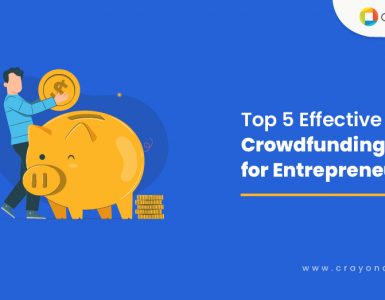

Add comment